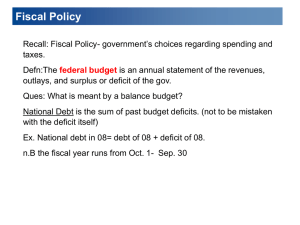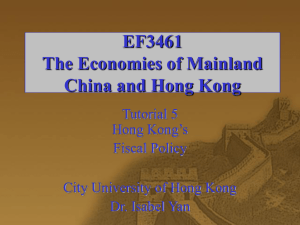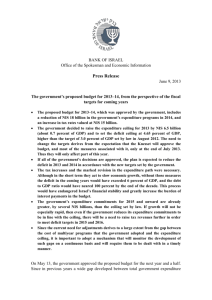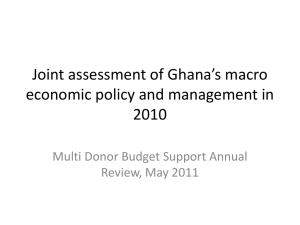viewed here - St. Lucia Chamber of Commerce
advertisement
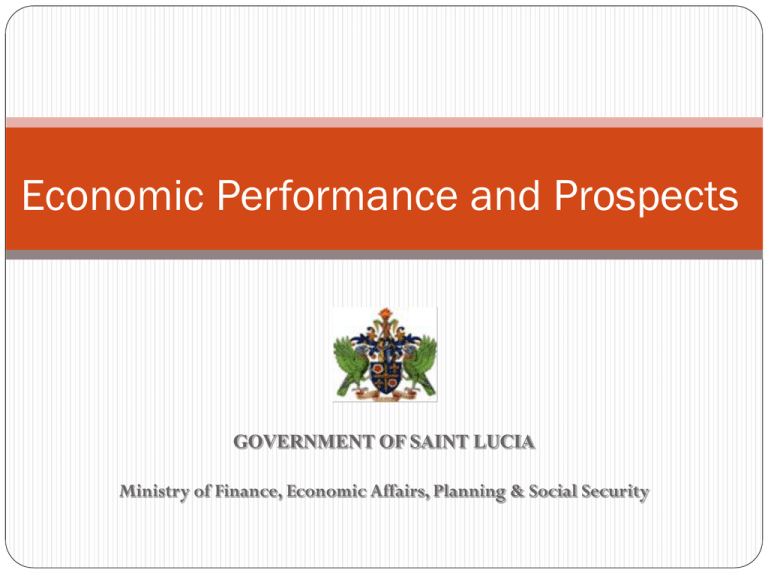
Economic Performance and Prospects GOVERNMENT OF SAINT LUCIA Ministry of Finance, Economic Affairs, Planning & Social Security Recent Economic Performance 2 Growth Performance Average growth of 2.5% over the last decade. GDP contracted by 0.6 percent in 2012 due to low external demand… St. Lucia and ECCU: Real GDP Growth (In Percent) 10.00 8.00 6.00 4.00 2.00 0.00 -2.00 2004 2005 2006 2007 2008 2009 -4.00 -6.00 -8.00 St. Lucia 3 ECCU 2010 2011 2012 Real Sector Review Baseline: Real Growth Rates (%) 2011 2012 Pre. Real GDP 1.0 -0.6 Agriculture -6.5 10.5 -37.6 45.3 Hotels -0.4 -1.5 Manufacturing 2.5 -4.7 Construction 2.1 -4.5 Distributive Trades 5.6 -5.4 Banking & Insurance -0.2 -1.0 Real Estate, renting & Business activities 1.0 2.1 Of which: Bananas 4 Trend In FDI FDI Inflows (In Percent of GDP) 30 25 20 15 10 5 5 2012 2011 2010 2009 2008 2007 2006 2005 2004 2003 2002 2001 - Commercial Bank Credit Growth in Credit (In Percent) 30.00 25.00 20.00 15.00 10.00 5.00 0.00 2004 6 2005 2006 2007 2008r 2009 2010 2011 2012p Fiscal Performance The fiscal position has deteriorated… Widening fiscal deficit, corrective measures required… Revenue and Expenditure (In percent of GDP) 40 35 Deficit: -10.7 30 25 20 Total Expenditure 7 Total Revenue and Grants Fiscal Summary Total Rev. & Grants 2009/10 826.8 % Change Current Revenue 759.6 % Change Current Expenditure 683.8 % Change Capital Expenditure 241.3 % Change Total Expenditure % Change 925.1 In EC Millions 2010/11 2011/12 874.5 926.7 2012/13 808.4 5.8 6.0 -12.8 787.8 839.5 784.9 3.7 6.6 -6.5 742.7 776.7 831.8 8.6 4.6 7.1 298.6 369.3 356.4 23.7 23.7 -3.5 1,041.3 1,146.0 1,157.0 12.6 10.1 1.0 8 Current Revenue Fall in current revenue due to reduce intake of taxes on income and international trade Changes in Current Revenue (In EC Millions) % Change in brackets Taxes on International Trade (-5%) Tax On Goods And Services (22%) Taxes on Income (-7%) 0.00 100.00 200.00 2011/12 9 300.00 2012/13 400.00 500.00 Current Revenue Fall in taxes on income driven by fall in corporate taxes… Changes in Taxes on Income (In EC Million) % Change in brackets Arrears (-29%) Corporations (-14%) Withholdings (9%) Individuals (4%) 0.00 10 20.00 40.00 60.00 2011/12 2012/13 80.00 100.00 Current Revenue Fall in international trade led by fall in excise tax (petroleum)… Changes in Taxes on International Trade In EC Millions % Changes in brackets Excise tax (Imports) (-30%) Service Charge (imports) (2%) Import Duty (-3%) 0.00 20.00 40.00 2011/12 11 60.00 2012/13 80.00 100.00 120.00 VAT Performance VAT Collections: ActualsYTD VS Budget (In EC Million) 120.00 98.05 100.00 80.00 60.00 54.21 47.08 40.00 37.63 20.00 0.00 Inland Revenue Customs and Excise Actuals (YTD) 12 Budget Current Expenditure Increases in current expenditure driven by higher interest payments, goods and services and transfers… Changes in Current Expenditure (% Changes in brackets) Goods and services (17%) Transfers (15%) 2011/12 2012/13 Interest Payments (20%) Wages and Salaries (3%) 0.00 13 50.00 100.00 150.00 200.00 250.00 300.00 350.00 400.00 Composition of Budget 2012/13 By Category of Recurrent Expenditure Transfers 10% Debt Servicing 24% Salaries & Wages 46% Goods & Services 20% 14 DEBT Debts levels are trending upwards… Public Debt 3,000 90 80 Right axis 2,000 60 50 1,500 40 1,000 30 20 500 10 - 0 Debt Levels 15 70 Debt / GDP (right axis) (In Percent) ($EC Millions) 2,500 Inflation Inflation uptick due to VAT but temporary… St. Lucia: CPI inflation (in percent, year-on-year) Headline inflation (no VAT) 5.0 VAT component Projection 4.5 4.0 3.8% 3.5 1.5 3.0 1.5 1.3 2.9% 1.5 2.5 4.3 2.0 3.2 1.5 2.8 1.0 2.5 2.3 3.0 3.0 3.0 0.5 Source: IMF Staff Report 16 2014Q4 2014Q3 2014Q2 2014Q1 2013Q4 2013Q3 2013Q2 2013Q1 2012Q4 2012Q3 2012Q2 2012Q1 2011Q4 2011Q3 2011Q2 2011Q1 2010Q4 2010Q3 2010Q2 2010Q1 0.0 Unemployment Unemployment climbing due to slow economic activity and structural problems in the labour market. Unemployment Rate (In Percent) 25 20 15 10 5 0 2004 17 2005 2006 2007 2008 2009 2010 2011 2012 (Q1) 2012 (Q2) 2012 (Q3) Challenges in curbing unemployment… Young demographic imply large inflows into the labour market Most of the unemployed are unemployable… According to the latest Labour Market Needs Assessment (LMNA) for Saint Lucia 60% of job seekers have educations levels below secondary school. Qualifications of Job Seekers/ Unemployed, Jul - Sep 2012 7% 33% Tertiary Education Secondary (with CXC) 60% 18 Below Secondary Level Where we are Vs Where we should be… Economic Performance and Targets (In Percent) Indicators 19 (2012 pre) (%) Targets (%) Growth Rates -0.6 3-5 Unemployment 20.7 ≤15 Inflation 4.2 2-3 Debt/GDP 80.2 60 Overall Deficit/GDP -12.9 3-5 Turning Point To bridge the gap government policy should aim to achieve the following: Boosting GDP Growth Removing structural impediments to growth Improve targeting of capital spending Maintaining Fiscal Sustainability Reduce overall deficit through fiscal consolidation Redirect debt on a more sustainable path 20 Growth is Key… Growth Jobs Economic Development Lower unemployment Higher Living Standards Reduce poverty 21 Improve Debt Ratios Growth leads to higher incomes… Impact of Growth on GDP (nominal) per Capita Country 22 Avg. GDP Growth (%) (2000-2011) GDP/Capita $US (2000) GDP/ Capita $US (2011) China 10.2 946 5, 417 Brazil 3.7 3,762 12,789 Singapore 5.9 22,791 50,714 Taiwan 4.2 14,641 21,592 Mauritius St. Lucia 4.2 3,992 8,511 2.5 4,622 7,379 We have some catching up to do… GDP per capita In $US Countries 23 GDP per Capita ($US) (2011 Est.) Bahamas 22,354 Trinidad and Tobago 17,060 Barbados 15,554 Antigua 12,760 St. Kitts 12,728 St. Lucia 7,379 Challenges to Growth Rapid wage growth coupled with low productivity growth has eroded competitiveness. Average Wages and Productivity (Indices, 1994=100, weighted by industry's share in total employment) 250 ULC (labor cost per unit of output) Average productivity (real output per employee) Average real wage 200 150 100 50 0 2011 2010 2009 2008 2007 2006 2005 Source: IMF staff estimates 2004 2003 2002 2001 2000 1999 1998 1997 1996 1995 1994 24 How do we boost Growth ? 25 Creating an Environment to Facilitate Growth Structural Reform Improve Investment climate to attract investment Improving Competitiveness Improving education and skill set for increase productivity 26 Infrastructure Development Target capital investment to projects that will facilitate export growth - North- South link road network -South Water Dam - Castries Redevelopment Investment in Renewable Energy Export Expansion Short Term • Explore strategies to increase tourist arrivals • Explore Latin America as a potential market • Attract investment in the areas of Health and EduTourism as the way forward. Medium term • Improve Business Climate • Infrastructural Development ( North South Road Network, Airport Improvement, Castries Redevelopment) • Improve training for greater absorption of current technology • Create greater linkages between tourism and other sectors 27 Fiscal Sustainability Reduce Overall Deficit: - Keep current expenditure flat - Prioritize Capital Spending: Ongoing projects and targeted capital projects 28 Reduce Borrowing Requirement: 100M Redirect Debt to a more sustainable Trajectory Curbing Current Expenditure… Setting WASCO on a sound financial footing Containing the wage bill Review of generalized subsidies (food, fuel) Public Pension Reform Reduce Current Expenditure 29 Curbing Current Expenditure Review of generalized subsidies (food, fuel) Scope for reducing generalized bulk food subsidies LPG subsidy not to exceed $15 per 20lb cylinder Containing the wage bill Setting WASCO on a sound financial footing to reduce expenditure on transfers Increase water tariffs to cover operating costs Reform of the Public Pension System 30 Capital Expenditure In the wake of global recession, the focus of government spending has been to; Generate economic activity through fiscal stimulus Reduce high unemployment rate However the current environment requires consolidation and streamlining of the capital budget. Currently 37% of capital budget is spent on maintenance Capital investment to focus not only on physical capital but on building human capital. 31 This will be Challenging… The experience of other countries demonstrate that structural adjustment and reforms are not easy to implement. Not many examples of countries seamlessly undertaking required adjustments prior to a crisis. The reality is that there will always be resistance to change. 32 Challenges… Fiscal adjustment will be difficult due to the current composition of government expenditure. Large percentage of recurrent expenditure is distributed to education, health and security (teachers, nurses and policemen). VAT and wage negotiations will impact current expenditure 78 percent of capital budget is ongoing projects. Scope for reductions is limited. Public sector reforms will involve revisiting the current legislative framework Re-examining the expectations of the state 33 Going Forward… Fiscal Adjustment Containing Current Expenditure Reduce the overall deficit by 100M Prioritize Capital Spending: -Ongoing projects -targeted capital projects -(formulate effective PPP arrangements to assist with financing growth inducing projects rather than incurring more debt) 34 Structural Reforms Improving the Investment Climate: -Fast tracking pending legislation -Training for unemployable to match needs of the labour market -Training to enhance technological adaption to increase the efficiency of business processes -Introduce standards for industry -More effective and targeted fiscal incentives framework -Accreditation for medical schools to facilitate expansion of the education tourism sector Public Sector Modernisation Means testing to better target subsidies to the poor to reduce cost of transfers. 35 Role of the Private sector Aggressively seek new investment opportunities including partnership with foreign investors Embrace competition and drive efficiency through adaptation of available technology Introduce and reach for standards in support of world class product and service delivery Play a strong, constructive and focused role in shaping government policy 36





